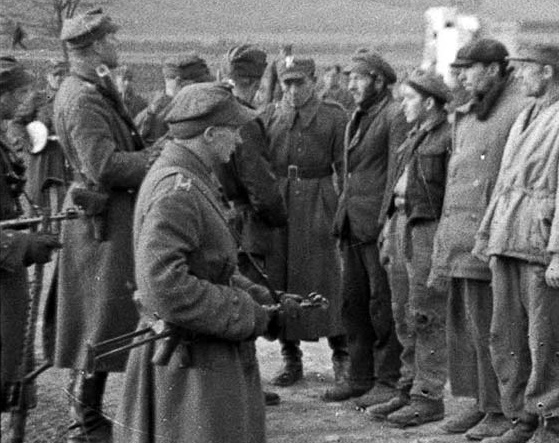
History 17/03/20 Why Poland deported 150 thousand of Ukrainians in the USSR after the war
With the end of the Second world war, Europe has experienced a substantial revision of the borders. A new reality not only stimulated the economic recovery from the devastation, but also launched many tragic events.
28 APR 1947 is a black day for the Ukrainians of Poland. They were deported during the operation “Vistula” from the South-East of the country on the newly annexed land in the Northwest.
the Background
In July 1945 the governments of the USSR and Poland signed an agreement on the exchange of population. Living in the Union of the poles and the Jews, who before the Second world war were citizens of Poland, was able to move home, and Belarusians, Ukrainians, Lithuanians of Poland could move to the Soviet Union.
From February to October, 1946, more than a million poles and Jews the decline of Poland, and in return, the USSR moved about 518 thousand people. The timing of the completion of the action was prolonged several times – officially on its completion was announced only to may 1947.
the Polish government has significantly erred in assessing the number of Ukrainians and kindred small Nations – and the Lemko Rusyns who remained in the country after resettlement. The Polish leadership hoped that he would be no more than 20-25 thousand people. However, the Ukrainians were in no hurry to leave the country. In addition to the reluctance to leave familiar places they were stopped by the fear of sending in the Siberian camps were affected by the propaganda of the Ukrainian nationalists, configured strongly against the Soviet regime. In addition, members of the OUN and UPA* (prohibited in Russia organizations) physically threatened people.
campaign Planning
By the beginning of 1947, the Communist authorities of Poland is seriously concerned about the actions of the Ukrainian guerrillas in the country. Detachments of the OUN and UPA* the summer of 1945 destroyed those who agreed to move to the USSR, killing of members of commissions on resettlement. Increasingly fixinvalidü the cases of burning of villages, of which planned the resettlement of Ukrainians. Civilians among the poles suffered serious damage from these actions.
Troops and security police of the Polish Republic were on stage and obviously couldn’t cope with the disobedience – it came down to the fact that some areas were beyond the control of authorities.
the Leadership of Poland started negotiations with the authorities of Czechoslovakia and the USSR on joint actions on suppression of activity of insurgents. 20 Feb 1947 Deputy chief of the General staff of the Polish army General Mossor sent to the Minister of defense and the Chairman of the State security Commission the list of Ukrainians – residents of 12 counties Ryashivska province – putting thought-out project check-out option.
the report stated the following: “Study the situation on the territory of the Krakow district identified a problem with the remnants of the Ukrainians. Many citizens and even families took refuge in forests or in the territories at the borders of Czechoslovakia and then returned home, providing a base for the UPA gangs*. Since the Soviet Union now more does not accept them, I believe it necessary to carry out the extra spring action of resettlement of these persons, being billeted on the returned areas for quick assimilation.”
Casus belli
In March 1947, the Polish leadership turned to the USSR with a request to take an additional twenty thousand Ukrainians. However, the leadership of the USSR, believing that earlier refused resettlement of people “have compromised gangsterism”, was refused admission, citing the lack of housing. After that, the Polish leadership considered the expulsion of Ukrainians, the only possible solution to the problem of the OUN-UPA(organization banned in Russia).
the Formal reason for the beginning of operation “Vistula” was the assassination of the Deputy Minister of national defence of Poland, General K. Sfericheskogo. He was killed on March 28, 1947 in battle with a detachment of the UPA under the command of major Hrina under the village Apple trees on the highway between Close and Belgoroda. It is noteworthy that nome historians dispute the fact of the death of General from the bullets of the fighters of the UPA on his jacket there was a cut on the back, showing the stab in the back.
the day of the murder was a ruling of the Politburo of the PDP: “rapidly move Ukrainian and mixed families returned to the area (primarily North Prussia), excluding the formation of compact groups”. The next day about the decision notified the Soviet Ambassador in Warsaw Viktor Lebedev.
15 April, the Minister of defence of Poland, field Marshal Michal Rola-Gimersky sent to the Ministers of defence of Czechoslovakia and the Soviet Union a request for a full blockade of their troops and the borders with Poland, so that no one be deported Ukrainians could not escape to neighbouring countries.
April 20, was finally approved plan of operation “Vistula”. It was decided to immediately install representatives of the Ukrainian intelligentsia and the clergy that served as the main engine of the Ukrainian underground, as well as to draw up a detailed list for a full eviction.
25 kilograms of things for the family
At 4 a.m. on April 28, 1947, about 17 thousand soldiers of the six divisions of the Polish army together with troops of the national security Service concluded in the ring areas of compact residence of Ukrainians. Simultaneously, units of the Czechoslovak army and the NKVD completely blocked the country’s borders to the South and East. Direct management of the operation was entrusted to the Minister of defence of Poland Marshal of the Rol-Gimersky and General Stefan Moszoro. April 29, the station went Kolesne the first part of the deported Ukrainians of the village of Dolice Savickogo County.
fees deportees were given two hours. Despite the categorical prohibition to bring not more than 25 kg per family things, some ventured to take with them livestock is later saved them from famine. Immigrants were settled in abandoned houses, sometimes destroyed by the Germans (the former owners) after the transfer of territories to Poland. The Ukrainians were forbidden to build churches, to open a national school. Inarea of Poland pursued any attempts of Ukrainians to cultivate in the home the national cultural traditions.
the Results of “operation Vistula”
the Three stage of the operation lasted from late April to October 1947. In three provinces of South-Eastern Poland the Ukrainians evicted 22 counties – they are distributed in 9 provinces of the North-West of the land formerly belonging to Germany. The decision of the authorities of the deported were accommodated at least 30 km from the sea and 50 km from the land border. They were forbidden to live closer than 30 km from the provincial cities. The operation ended with the arrest of escaped from new places of Ukrainians who returned to their homes.
Just deported were subjected to 150 thousand people – both ethnic Ukrainians and mixed families. A lot of villages burnt down during the sweeps, now there are vacant lots or impenetrable forests.
the Jaworzno concentration Camp took almost 4 thousand people who were suspected of cooperation with the OUN and the UPA, including 27 priests and 823 women. He was shot more than 100 people, nearly 200 died from torture. No one counted how many settlers died of poverty and hunger in the first months after deportation. Troops of the Polish army was destroyed 1178 shelters, bunkers, eliminated 1509 fighters of the OUN-UPA.
Implications
In 1956, the leadership of the Republic of Poland, the deportees were allowed to change the place of residence by prior arrangement. By the time the authorities acknowledged the inadmissibility used during the deportation of force, but not criticized the necessity of the action.
Only after the collapse of the socialist bloc in August 1990, the Senate officially condemned the forcible eviction of Ukrainians and Lemkos in the process of “operation Vistula”. In 2007, the presidents of Ukraine and Poland signed a joint statement in which they strongly condemned the deportation.
*(banned organization in Russia)
Russian Seven
Source:
© Russian Seven
Recommended statesalaska… Share: Comments Comments on the article “Why Poland deported 150 thousand of Ukrainians in the USSR after the war” Please log in to leave a comment! br>
Share on Tumblr
















